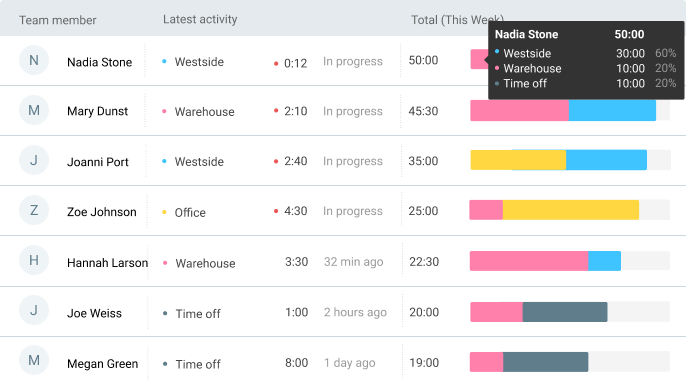What is absenteeism? Causes and consequences
Last updated on: September 28, 2023
Are your employees absent from work frequently?
Habitual absence from work is known as absenteeism — an issue that can affect productivity, work continuity, and the overall performance of a business.
But, what exactly is absenteeism and what causes it?
In this blog post, we’ll explore the meaning of absenteeism, its causes, and consequences. We will also equip you with 10 strategies that help you minimize the adverse effects of absenteeism.
Let’s begin!

Table of Contents
What is absenteeism in the workplace?
Absenteeism is when employees are absent from work when they are scheduled to be working. The reasons for employee absenteeism can range from illnesses, family problems, stress, to other factors.
One of the definitions of absenteeism is given by the authors of a research paper titled Managing absenteeism in the workplace: the case of an Italian multi utility company that explains absenteeism as the “habitual absence from work for one or more days, usually justified by a medical certificate, but actually due to personal interests and poor sense of duty.”
To what extent does absenteeism occur in workplaces? You might be surprised if you haven’t been following the statistics.
According to the Bureau of Labor Statistics (BLS), out of 118,745 employees in numerous industries, the total of 3.6% of employees in the US were absent from work in 2022 due to different reasons.
Regardless of the reason, absenteeism can impact workplace productivity, increase workload for other colleagues, disrupt project timelines, to name a few.
What is the difference between absence and absenteeism?
While the terms are often used interchangeably, there is a significant difference between absence and absenteeism.
Namely, absence refers merely to “failure to be present at a usual or expected place or at the agreed time.” The term only signifies that someone is not present at a certain place or time without specifying the reason or the duration of absence.
Moreover, the term does not specifically refer to the absence of employees at the workplace.
On the other hand, absenteeism specifically refers to the frequent and habitual pattern of employees being absent from work, often without valid reasons or proper authorization.
Types of absenteeism in the workplace
There are several ways of categorizing types of absenteeism in the workplace — but these three types are the most common:
- Planned or approved absenteeism,
- Unplanned, unexcused, or unscheduled absenteeism, and
- Chronic or excessive absenteeism.
Type #1: Planned or approved absenteeism in the workplace
Planned or approved absenteeism involves instances of absences that are scheduled and planned in advance.
Examples include:
- Vacations,
- Personal time off, and
- Prearranged time away from work.
Companies typically define the timeframe for obtaining the approval for these planned absences in their attendance policy — as the Fair Labor of Standards Act (FLSA) does not mandate the number of leaves or the timeframe for informing employers.
For example, the attendance policy of the University of South Florida states that the approval for planned leaves must be taken “at least 24 hours in advance and must be done in compliance with any departmental policies regarding scheduled time off.”
Type #2: Unplanned, unexcused, or unscheduled absenteeism in the workplace
Emergencies, such as illness or death of a loved one, are typically the reasons for taking unplanned leaves. Companies do recognize the need for such leaves when the reasons are genuine and employees are not penalized for these absences.
However, when employees are absent from work without notifying the employer/supervisor or providing a reason for doing so, they can be grounds for disciplinary action. Such unauthorized absences, also called ‘unexcused absences,’ are not authorized by the employer and may not align with the organization’s policies for taking time off.
Each company determines the disciplinary actions (such as warnings, suspension, or termination) to address unexcused absences which can escalate with repeated instances of such absences.
Type #3: Excessive or chronic absenteeism in the workplace
Frequent and prolonged absences are categorized as chronic or excessive absences. As there is no standard definition of excessive or chronic absence given by the Fair Labor of Standards Act (FLSA), each company determines what constitutes excessive absences.
For example, Case Western Reserve University defines excessive absences in its attendance policy as:
“…repeated occurrences (more than 6 in 6 months) of unscheduled absence(s) and/or tardiness unrelated to approved time off where 1 occurrence = 1 to 5 consecutive days of unscheduled absence or 3 incidents of tardiness, or 2 incidents of partial absence.”
To understand how companies and HR professionals define excessive absences, we reached out to Ryan Mckenzie, the Co-Founder & CMO of Tru Earth, a company that makes eco-friendly household products. Ryan’s company defines chronic absenteeism as one that disrupts the company’s productivity:

“Chronic absenteeism is a persistent pattern where an employee misses more than the allotted annual leave or sick time off. Though some unexcused absences may be inevitable in the ordinary course of life, we believe more than three unexcused absences in six months may impact team synergy and productivity.”
💡Clockify Pro Tip
Another term you may have come across in this context is ‘no call, no show’ that refers to a situation when employees are absent from work without informing the employer in advance. Learn more about ‘no call no show’ situations and get actionable tips and templates to tackle absenteeism head-on in the following blog post:
What causes absenteeism?
Absenteeism at work can stem from a variety of factors that may also impact employee engagement and productivity.
Let’s look at what the causes of absenteeism are.
Cause #1: Mental and physical health issues
Both physical and mental health issues contribute to absenteeism. In January 2022 alone, 7.8 million employees were absent from work because of a medical problem (such as an injury, illness, etc.), according to the BLS.
What’s more, the same source states that 4.2 million full-time workers worked part time due to an illness, medical problem or appointment in the same period.
While the medical problems can vary, the Centers for Disease Control and Prevention (CDC) lists the top five chronic diseases that lead to absenteeism in the workplace:
- Diabetes,
- High blood pressure,
- Physical inactivity,
- Smoking, and
- Obesity.
Apart from these, mental health issues, such as depression and anxiety, also account for a loss of 12 billion workdays each year, according to the World Health Organization (WHO).
Anxiety or depression also impacts productivity at work in many ways, by making it difficult for the sufferers to concentrate or collaborate.
When talking about mental health, we cannot afford to ignore the topic of stress.
Data compiled by the American Institute of Stress shows that while 83% of workers in the US experience work-related stress, 1 million are absent from work every day because of stress.
Cause #2: Lack of job satisfaction
What makes people love their jobs and want to come to work everyday (a.k.a., job satisfaction)? As it turns out, there are multiple factors.
Here are the factors that contribute to job satisfaction, according to a recent survey conducted by The Conference Board:
- Salary and bonuses,
- Recognition,
- Workloads/work-life balance,
- Promotion policies,
- Performance review,
- Job security,
- Job training programs,
- Quality of leadership,
- Workplace culture, and
- Benefits (such as, retirement plans, sick days, vacation/family leave policies).
The absence of one or more of these factors can lead to job dissatisfaction.
And, employees who are not happy with their jobs are more likely to seek ways to avoid the workplace. A study that examined the relationship between job satisfaction and absenteeism found that the higher the level of job dissatisfaction, the longer the absenteeism in the workplace.
Cause #3: Accidents and injuries at the workplace
Accidents and injuries that lead to absenteeism are, unfortunately, all too common. In 2021 alone, 2.6 million workplace injuries (nonfatal) were reported by employers in the private industry, according to the BLS.
What causes these injuries?
Data from CDC shows that the top three causes of work-related injuries resulting in prolonged absenteeism in 2020 were:
- Contact with equipment and objects,
- Slips and falls, and
- Overexertion.
In addition, it’s ergonomics — i.e. the ideal way of arranging the work environment to minimize strain and injuries while maximizing comfort and efficiency — can also be a problem, according to Occupational Health and Safety Administration (OSHA).
Poorly designed workplaces and processes can lead to stressors, such as prolonged sitting/standing, awkward postures, excessive noise, vibrations, repetitive motions, and heavy physical loads. They can, in turn, lead to mental and physical exhaustion, increasing the risk of work-related accidents — and absenteeism.
In fact, a study that examined the link between absenteeism and working conditions showed that the more the employees are exposed to the above-mentioned stressors, the longer they are likely to be absent.
Cause #4: Burnout
Burnout is a fallout of workplace stress. According to the International Classification of Diseases (ICD-11) that classifies and defines medical conditions: “Burnout is a syndrome conceptualized as resulting from chronic workplace stress that has not been successfully managed.“
While career burnout can have multiple causes (lack of rest, unreasonable workload, or a toxic workplace), it leads to low productivity and increased absenteeism.
In fact, a Gallup study titled Employee Burnout: Part I: The 5 Main Causes, found that employees who experience burnout:
- Are 63% more likely to avail sick leaves,
- Are 2.6 x more inclined to seek another job, and
- Experience a 13% dip in confidence levels.
Burnout, characterized by feelings of negativism, mental, and physical exhaustion, can make it challenging to muster the energy and motivation to go to work.
Cause #5: Negative work culture
What exactly do we mean by work culture? After all, it’s not something you can touch or see.
Founder and CEO of The Purposeful Culture Group, a culture consulting firm and author, S. Chris Edmonds, offers a simple definition of organizational culture in a podcast.
“Culture is all about how people treat each other — how leaders treat their teams and peers, how employees treat each other, and how people treat customers and vendors. It’s about relationships and respect.”
In a workplace with a positive work culture, team members treat each other with respect and courtesy. When there is an atmosphere of trust, employees have clarity over their responsibilities and the company’s goals.
Conversely, here are some of the hallmarks of a workplace with a negative culture:
- Lack of direction and clear objectives,
- Poor communication,
- Work overload and poor work-life balance,
- Micromanagement,
- Discrimination and harassment,
- Lack of company values, etc.
Not only does bad workplace culture impact productivity and mental health but it also leads to excessive absenteeism at work. When researchers at Culture Shift surveyed 1,000 workers in the UK, they found that 71% of them had taken sick leave to avoid seeing someone at work whom they had a negative relationship with.
That’s not all. The same source found that as many as 61% of employees who experienced discrimination, bullying, or harassment at work took long-term leave.
Toxic work culture is also the top factor prompting 30% of the employees in the US to consider quitting their job, according to a 2022 FlexJobs survey.
💡Clockify Pro Tip
Learn how to identify and navigate toxic work environments in our latest article:
Cause #6: Family responsibilities
Employees who have family responsibilities, such as caring for children, elderly parents, or family members with disabilities, often need to take time off work to attend to their caregiving duties.
According to a 2020 report titled Caregiving in the US, caregivers spend around 23.7 hours each week on caregiving duties.
Balancing work and family responsibilities can be challenging, especially when both require significant time and attention. A lack of family-friendly policies at the workplace, transport problems, emotional, and physical stress, can all add to the problem of absenteeism.
But, why is absenteeism such a big deal?
In the next section, we will look at the cost of absenteeism to help you understand why the problem must be addressed promptly.
What is the cost of absenteeism in the workplace?
The cost of absenteeism in the workplace refers to the impact of employees being absent from work. For example, when an employee is absent, their colleagues have to take over the absent employee’s workload, potentially leading to overtime expenses.
Here’s a list of the costs associated with absenteeism:
- Reduced productivity: The cost of absenteeism can run into millions of dollars as a result of reduced productivity. According to CDC’s research, mentioned earlier, employers face a cost of $36.4 billion each year due to absenteeism from chronic illnesses and the resulting reduced productivity.
- Hiring and training replacement workers: When companies hire replacement workers, they bear the costs of payroll and training in addition to productivity loss. A study from Circadian titled Absenteeism: The Bottom Line Killer found that each year, absenteeism costs employers $3,600 per hour per employee. What’s more, the payroll costs of replacement workers can be 50% higher than the wages of the employee who is absent.
- Low team morale and disengagement: Absenteeism can affect colleagues, teams, and the organization as a whole. For instance, if the management increases the workload of the absent employee’s team members, these employees can face burnout, stress, and low engagement levels.
- Damage to brand reputation: Disengaged and unhappy employees may not be delivering their best performance at work, which can translate to costly mistakes, poor quality products, or unhappy customers. All of these factors can hurt a company’s reputation and result in increased work absenteeism.
- Insurance premium costs: Absenteeism related to illnesses and workplace accidents pushes up the costs of medical care and Workers’ Compensation Insurance (a type of insurance that covers the income loss and medical care expenses for injured workers). The more frequent the claims related to workers’ compensation in a company, the higher the premium rates.
As you can see, absenteeism can affect productivity, quality, and engagement levels, all of which can impact the company’s reputation and profit in the end.
How do you manage absenteeism in the workplace?
From establishing clear policies to creating a culture of open communication, the following tips can help you address and control absenteeism effectively.
Tip #1: Establish a clear attendance policy
Creating a detailed attendance policy is perhaps the first step to curbing absenteeism.
When drafting the policy, be sure to involve the employees and the top leadership. Consider the nature of work, the company’s needs, and the legitimate needs of your employees.
Clearly define what constitutes acceptable and unacceptable absences, including tardiness, unscheduled leave, chronic/excessive absence, and extended time off.
Be sure to describe the process for reporting absences and the time period for doing so. Outline how and when employees should notify their supervisors or the HR department about their absence, whether it’s due to illness, personal reasons, or planned vacations.
Mention any required documentation for absences, such as medical certificates or other relevant proof and the deadlines for submitting such documents.
Finally, explain the consequences of non-compliance with your attendance policy. Here’s an example from the Connecticut Department of Administrative Services:
| Number of occasions of unexplained absences | Disciplinary action |
|---|---|
| 9 occasions in 12 months | Unsatisfactory attendance can result in a ‘below threshold’ performance rating unless you provide the necessary documentation for your absence. Receiving two “Unsatisfactory” performance appraisals can result in dismissal from service. |
💡Clockify Pro Tip
Unlock the secrets of an effective employee attendance policy. Check out our blog post:
Tip #2: Identify patterns of absenteeism
Keep accurate records of employee absences and analyze the data to identify patterns. This will help you understand the reasons behind absenteeism and target specific areas for improvement.
How to track absenteeism? By keeping an eye on employee attendance.
An easy way to keep track of attendance and the number of hours each employee works is to use a free attendance tracker, such as Clockify.
Once you create an account on Clockify, you can send email invites to your team members to join your workspace. After logging in to Clockify, employees can start the timer on the browser, the desktop, or the mobile app (or they can add hours manually).
With the Team Dashboard, you can view who is currently working on what, their last activity, and a visual breakdown of their workweek.

You can also get a report on all your employees’ attendance for a specific time period, including their:
- Break time,
- Overtime,
- Start time, and
- End times.

Once you track the data, you can categorize absences based on reasons, such as illness, vacation, personal leave, or other types, that can help you understand the primary causes of employee absenteeism.
With Clockify, you can observe trends and patterns of absenteeism over time and compare the data across different departments, teams, seasons, or job roles. This can help identify specific roles or departments with high absenteeism.
While this gives you an idea as to the extent of absenteeism, you can conduct surveys or focus group discussions with employees to understand the reasons behind absenteeism.
The insights you gain from these methods can help you design a strategy to prevent absenteeism.
Tip #3: Implement workplace wellness programs
Work-related stress, according to the CDC, is the leading health problem at the workplace. Work stress can increase the risk of chronic diseases and as we already saw in the section on the reasons for absenteeism, chronic diseases can lead to absenteeism at work.
Workplace wellness programs that address both mental and physical well-being can help you curb absenteeism.
For instance, Nike offers free counseling sessions to their employees on a wide range of mental health issues, including depression, substance abuse, anxiety, building resilience, and so on.
Others, such as Tru Earth, encourage employees to prioritize rest and relaxation. Ryan Mckenzie explains how their company ensures rest and relaxation:

“We encourage taking mental health days and highlight the importance of rest and relaxation, encouraging our employees to make use of their vacation time fully.”
But, the type of wellness program you offer at your company will depend on what your employees need.
To design a custom wellness program for your employees, here are some steps to follow:
- Conduct a survey to identify the health and wellness needs of your employees,
- Set clear objectives for the wellness program, such as reducing absenteeism,
- Ensure you receive support from the top management for the wellness program,
- Consult experts to design a wellness program that addresses physical, mental, and emotional health,
- Use multiple communication channels to create awareness on the wellness programs, and
- Offer incentives to encourage employee participation.
Tip #4: Address safety concerns
Making the workplace safe and healthy is vital to minimize absenteeism related to accidents, slips, and falls.
Begin by identifying potential hazards at the workplace that can increase slips, trips, and fall risks.
The best way to identify hazards is to consult workers. According to the OSHA, workers are “in the best place to identify safety and health concerns such as hazardous situations, unsafe conditions, close calls/near misses, and actual incidents.”
Based on OSHA’s recommendations, here are some other things you can do to make your workplace safe and healthy and reduce work absenteeism as a result:
- Ensure the workplace is clean and clutter-free,
- Provide adequate lighting in all areas that help reduce accidents,
- Install non-slip flooring materials in areas prone to wetness,
- Prevent tripping hazards by securing cables, cords, and other mobile equipment,
- Repair loose carpets, damaged flooring, and uneven surfaces,
- Install handrails on stairs and other areas where employees may need support,
- Use clear and prominent signage to indicate potential hazards,
- Consult experts to design ergonomic workspaces, and
- Conduct regular safety training for all employees.
Tip #5: Create a positive work culture
Although the reasons behind employee absenteeism can be multiple, a toxic workplace is often one of the leading causes. Eliminating toxic behavior at the workplace needs a systematic and dedicated approach.
Namely, leaders need to demonstrate positive behaviors, such as transparency, trust, respect, and collaboration.
Companies that have a positive work culture in addition to strong leadership, benefits, and work-life balance consistently rank as the best places to work in Comparably’s list of Best Global Company Culture.
Other factors that have helped companies, such as Elsevier and Chegg, rank in the above-mentioned list include a work environment that is “inclusive, equal, and joyful.”
Other than these, here are some other strategies to cultivate a positive work culture:
- Create a mission statement describing values, beliefs, and desired behaviors,
- Establish a safe environment for employees to voice their opinions and concerns,
- Communicate clear expectations regarding roles and responsibilities,
- Appreciate and reward employees’ efforts and achievements,
- Include treatment of others into employee’s performance evaluation,
- Create awareness on desired and unacceptable behaviors, and
- Address conflicts and disagreements in a constructive manner.
Tip #6: Neutralize burnout and stress
The first step to addressing and preventing employee burnout is to know how to recognize the signs of it, which can often be subtle.
Some common signs to watch out for to spot burnout include:
- Lack of participation in team events or withdrawal from interactions,
- Increase in preventable errors,
- Pessimism, irritability, or cynicism,
- Inability to focus or take decisions,
- Reduced self-confidence, and
- Frequent health problems.
To neutralize burnout, you can establish frequent check-ins with employees and make a plan of action to address the specific challenges they face at the workplace. Depending on the concerns of the employee, the plan of action can include:
- Flexible work timings,
- Reduced workload,
- Counseling/therapy sessions,
- Wellness programs, and
- Career development sessions.
Tip #7: Encourage collaboration
While collaboration is a component of a positive work environment, it needs special mention here, given its importance in reducing absenteeism.
In his research paper titled Strategies to Reduce Absenteeism in the Public Sector Workplace, Dr. John G. Turner found that a collaborative work environment reduces absenteeism by promoting employee engagement.
In this study, one of the leaders interviewed said:
“I would like to have more events such as cook-offs and team building contests to help keep the employees motivated which may help with deterring absenteeism in the workplace.”
Another leader said:
“We always look for reasons on why employees were not coming to work and noticed there was a lack of collaboration with management that did not allow for employee engagement.”
Not only does a collaborative environment provide an avenue for employees to share skills and knowledge, but also promotes problem-solving and decision-making.
But, how to promote collaboration when you have a dispersed workforce?
A seamless way to promote real-time communication and collaboration among remote teams is to use team collaboration apps, such as Pumble. With powerful features, such as video conferencing, channels, individual, and group messaging, Pumble offers all that you need to keep your teams connected and engaged.
Tip #8: Provide career advancement opportunities
By offering career advancement opportunities, not only do you enhance employee skills and engagement but also create a sense of loyalty and commitment.
Employees who see a clear path for growth within the organization are more likely to invest in their roles, leading to reduced absenteeism and higher job satisfaction.
Here are some ways to offer career development opportunities:
- Work with employees to create career and skill development plans,
- Provide regular training sessions, workshops, and seminars,
- Implement mentorship programs where experienced employees guide less experienced colleagues,
- Offer online courses so that employees can learn at their own pace, and
- Support employees in obtaining relevant certifications to enhance their skills.
Tip #9: Recognize and reward employees
A little appreciation goes a long way in reducing absenteeism.
Want more proof?
82% of Americans whose efforts were recognized reported being happy at work in a survey conducted by Curiosity at Work. And, as we all know, happy and engaged employees are less likely to be absent from work.
Another study titled Reducing Absenteeism and Rescheduling Among Grocery Store Employees With Point-Contingent Rewards found that rewards reduced absenteeism among employees. Rewards also helped reduce the instances of their leaving early from work.
Here are some ways to implement a reward system that help reduce employee absenteeism:
- Decide the behaviors and actions that merit recognition,
- Ensure that the desired behaviors align with the organization’s core values and goals,
- Establish measurable criteria for each behavior. For example, the attendance policy can specify 80% attendance in any given month as a measurable criteria,
- Decide on the types of rewards, such as monetary incentives or career advancement opportunities,
- Acknowledge achievements and contributions,
- Create a system where managers offer instant recognition and praise when they observe outstanding behavior,
- Clearly communicate the rewards and recognition program to all employees, and
- Track and measure the impact of the rewards and recognition program on absenteeism rates and overall employee engagement.
Tip #10: Implement a work-family policy
If you’re looking to reduce absenteeism, another area to focus on is to become a family-friendly workplace.
By implementing a work-family policy (WFP), you can ensure workers who are caregivers have adequate support to manage their work and caregiving responsibilities.
WFP can offer:
- Flexible work timings and arrangements,
- Parental leave (paid and unpaid),
- Office daycare or paid child care, and
- Family caregiving leave.
However, ensure that you follow the rules and regulations that are in place in your state, especially those regarding parental leave, before implementing any of these policies.
FAQ about absenteeism in the workplace
Have more questions about absenteeism in the workplace? This section focuses on providing answers to commonly asked questions on absenteeism.
What is chronic absenteeism?
Chronic absenteeism indicates frequent absences from work that can impact the company’s productivity. However, there is no universally agreed definition of what constitutes chronic absenteeism.
The definition can vary based on company policies, industry norms, and individual circumstances.
As there is no standard definition of chronic absenteeism in the work context, we can take a look at how schools define the term to improve our understanding.
In the academic context, chronic absenteeism is when a student misses 10% of days in a school year that includes both unexcused and excused absences.
For instance, if a student misses 2 days in a month, every month of the year, the student has been absent for 18 to 20 days, which is chronic absenteeism.
💡Clockify Pro Tip
Simplify record-keeping and monitor absenteeism trends with these user-friendly templates:
What is excessive absenteeism?
Excessive absenteeism is a pattern of frequent absences from work, beyond what is considered normal or acceptable.
While the reasons for prolonged or repeated absences can be illness, personal reasons, or other factors, excessive absenteeism can disrupt employee performance and productivity.
There is no standard definition of what constitutes excessive absenteeism as each company has its own policy.
For instance, Vikas Kaushik, the CEO of TechAhead, defines excessive absenteeism as one that results in project delays:

“We define excessive absenteeism as when an employee frequently delays projects with unscheduled absences. We strive to keep unexcused absences below 2% of all working days because we think it’s important to strike a balance between personal needs and professional obligations.”
How much unexcused absenteeism is acceptable?
The acceptable level of unexcused absenteeism can vary widely depending on factors such as:
- The nature of the job,
- Industry norms,
- Company policies, and
- The overall impact of absenteeism on the organization.
While there is no universally defined limit for unexcused absenteeism, many organizations have specific attendance policies that describe the acceptable level of absenteeism, both excused and unexcused.
Is absenteeism caused by stress?
Stress is one of the most common reasons that contribute to absenteeism. As mentioned earlier, 83% of employees in the US experience work-related stress, according to the American Institute of Stress. What’s more, the same study shows stress is the reason why 1 million workers are absent from work on a daily basis.
All the tips given above can help companies mitigate workplace stress and reduce absenteeism.
What is presenteeism?
Presenteeism refers to situations when workers are at the workplace but are not able to work at their usual capacity due to different reasons.
In his research article titled Presenteeism: At Work–but out of it, Paul Hemp defines presenteeism as “the problem of workers being on the job, but, because of illness or other medical conditions, not fully functioning.”
While this is not done intentionally, presenteeism can also affect productivity and in turn, the company’s bottom line, just like absenteeism.
How to calculate an absentee rate?
To calculate the absentee rate or absenteeism rate of an employee, use the following formula:
(Total number of days or hours absent / The available work days or hours in the specific period ) x 100
Let’s see how to calculate an absentee rate using an example.
John works 25 days a month (5 days each week). In July of 2023, he was absent for 5 days.
Now, let’s calculate the absentee rate using the above formula.
Total number of days John was absent = 5 days
The available work days in July = 25 days
Absenteeism rate = (5 /25 ) x 100
= 0.2 x 100 = 20
This shows that the absenteeism rate is 20% or that John lost 20% of work days due to absenteeism.
You can calculate the absenteeism rate for an individual, a department, or the company on the whole by using this simple formula.
What is the average absence rate?
The average absence rate is the same as the absenteeism rate and these two terms are used interchangeably. Absence or absenteeism rate refers to the amount of time an employee is absent from work and is expressed as a percentage.
The formula used to calculate absence rate is the same as the one you would use for absenteeism rate:
Absence rate = (Total number of days or hours absent / The available work days or hours in the specific period ) x 100
💡Clockify Pro Tip
Enhance your attendance management process by checking our our latest blog post:
Final thoughts: Take a proactive approach to conquer absenteeism
Clearly, employee absenteeism is a multifaceted challenge that can significantly impact a company’s productivity, morale, and profit.
However, by understanding the root causes of it and by implementing effective control measures, you can create a more positive work environment, improve employee well-being, and reduce absenteeism rates to a minimum.
From addressing health issues and promoting work-life balance to creating a positive work culture, the strategies we have discussed in this blog post offer a comprehensive approach to managing and preventing absenteeism.
Keep in mind that a proactive and ongoing approach that focuses on employee engagement, wellness, and career growth not only neutralizes absenteeism but also helps build a workplace where employees are motivated to do their best (and more)!
✉️ Have you employed a strategy or two to successfully reduce absenteeism? Share your tips at blogfeedback@clockify.me so we can highlight them in our upcoming posts. If you found our blog post to be insightful, go ahead and share it with your colleagues, friends, and peers.




